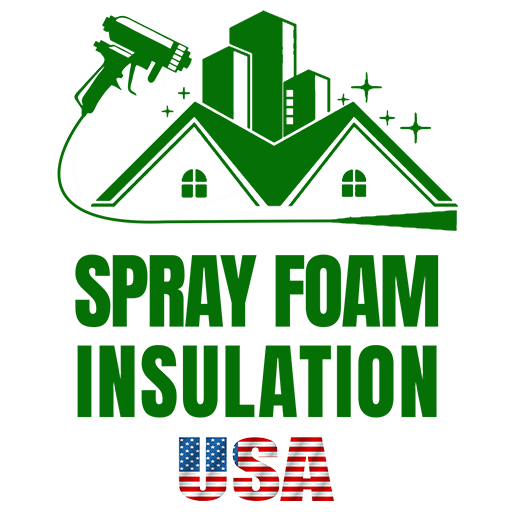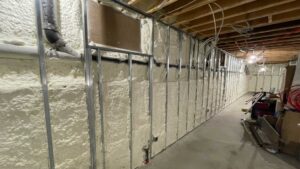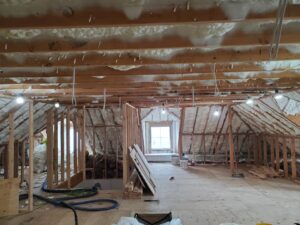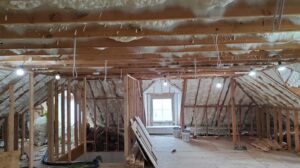When you search for ‘air seal insulation’, you’re likely looking for ways to make your home or business more comfortable, save on energy bills, and do something good for the planet. Here’s the quick scoop:
- Air sealing stops unwanted air from coming in or going out of your home.
- Insulation keeps your desired air (warm in winter, cool in summer) inside, making your space more comfortable and your energy bills lower.
Both air sealing and insulation are key to a home that feels just right, costs less to keep comfortable, and is kinder to the environment.
Air sealing and insulation are not just about staying cozy or cutting costs; they’re about creating a healthier, more energy-efficient space. Whether you own a small apartment in the city or a large office in the suburbs, understanding the benefits of proper air seal insulation can transform your living and working environment. Think of your building as a protective shell. Air sealing is like closing all the gaps in that shell, so no energy leaks out, making insulation the armor that keeps the internal temperature just the way you want it. This simple yet effective combination can lead to significant energy savings and a noticeable increase in comfort year-round.
Yet, the journey to a well-sealed and insulated property can seem complex. Fear not! By breaking down the concepts to their basics, we aim to provide you with the knowledge you need to make informed decisions about air sealing and insulation for your home or business. Let’s explore how these simple changes can lead to big benefits for both your wallet and the planet.

Understanding Air Seal Insulation
When it comes to making your home more energy-efficient and comfortable, understanding air seal insulation is key. Let’s dive into what it is, why it’s important, and the types that can make a difference in your home.
Types of Insulation
There are several types of insulation, each with its own benefits:
- Spray Foam: Acts as both insulation and air barrier, sealing gaps and preventing air leakage.
- Caulk: Used for sealing small cracks and gaps around windows, doors, and other openings.
- Weather Stripping: Applied to movable components like doors and window frames to seal gaps.
- Rigid Foam: Stiff panels of insulation that can be used to insulate walls, roofs, and foundations.
Energy Loss
A significant amount of energy can be lost through unsealed nooks and crannies in your home. This loss not only leads to higher utility bills but can also make your home less comfortable by allowing drafts and uneven temperatures.
Spray Foam
Spray foam insulation is a powerhouse when it comes to air seal insulation. It expands to fill cracks and crevices, creating a tight seal that blocks air movement. This can dramatically reduce energy loss, making it a popular choice for both new construction and retrofit projects. Its ability to conform to any shape also makes it ideal for sealing irregular spaces.
Caulk and Weather Stripping
For smaller jobs, caulk and weather stripping are effective and inexpensive ways to seal air leaks. Caulk is perfect for stationary cracks and joints, while weather stripping is designed for parts of the house that move, like doors and windows.
Rigid Foam
Rigid foam boards add insulation and can help air seal your home when installed correctly. They’re particularly useful in attics and basements, where they can be applied to walls or ceilings to block unwanted airflow.
Why It Matters
Sealing air leaks and adding insulation can lead to significant energy savings. As mentioned, air leakage can account for 30% or more of a home’s heating and cooling costs. By addressing these leaks with effective air seal insulation, you can enjoy a more comfortable home environment and lower energy bills.
Whether you’re tackling a DIY project or planning a larger renovation, understanding the role of air seal insulation is the first step towards a more energy-efficient home. With the right approach, you can minimize energy loss and make your living space more comfortable year-round.
The Importance of Air Sealing Your Attic
When it comes to making your home more energy-efficient, the attic is a key player. It’s not just about adding more insulation; it’s about making sure the warm or cool air you’re paying for stays where it’s supposed to. Let’s dive into why sealing your attic is a smart move.
Energy Savings
First off, air sealing your attic can lead to substantial energy savings. Imagine your home as a big thermos. If the lid isn’t tight, the content either cools off or heats up quickly, right? Your attic works the same way. Studies have indicated that proper attic insulation and air sealing can reduce your heating and cooling costs by up to 10%. That’s like saving a dime on every dollar you spend on energy!
Preventing Ice Dams
For those living in colder climates, ice dams can be a real headache. They form when heat escapes from your attic, melts the snow on your roof, and then refreezes at the edge. This cycle can cause significant damage to your roof. Air sealing your attic keeps the heat inside, preventing the thaw-freeze cycle that leads to ice dams. It’s a straightforward solution to a potentially costly problem.
Temperature Control
Ever noticed how some rooms are too hot in summer or too cold in winter? That’s often due to air leaks in the attic. By sealing these leaks, you can achieve more consistent temperatures throughout your home. It’s about comfort, not just costs. Imagine your entire home feeling like that one room that’s always just the right temperature. That’s the power of a well-sealed attic.
Attic Sealing Techniques
So, how do you seal an attic? It starts with identifying where the leaks are. Common culprits include gaps around light fixtures, chimneys, and ductwork. Sealing these leaks can involve a variety of materials, but here are a few effective strategies:
- Spray Foam: This is a great option for filling gaps and cracks. It expands to fill the space and creates a tight seal.
- Weather Stripping: Applying weather stripping around the attic entryway can prevent air from slipping through the cracks.
- Rigid Foam Boards: These can be used to cover larger areas that need to be sealed off, such as the attic floor or walls.
The goal is to create a continuous barrier that keeps your conditioned air in and the outside air out. It’s like wrapping your home in a cozy blanket.
In conclusion, air sealing your attic is a crucial step toward not only saving money on energy bills but also creating a more comfortable and consistent indoor climate. Whether you’re doing it yourself or hiring a professional, the benefits of sealing those leaks are too significant to ignore. Now, let’s move on to understanding the costs associated with air sealing your home and how to make it as cost-effective as possible.
Cost of Air Sealing Your Home
When it comes to making your home more energy-efficient, knowing about the cost of air sealing is essential. It’s an investment that not only pays off in reduced energy bills but also in enhancing the comfort of your living space. Let’s break down what you can expect to spend and how to do it without breaking the bank.
National Average
The cost of air sealing your home can vary widely. On average, homeowners might spend between $5,000 and $12,000 for a comprehensive air sealing and insulation project. This range can fluctuate based on several factors, such as the size of your home, its location, and the extent of the air sealing needed. It’s not just about stopping drafts; it’s about creating a more energy-efficient home.
Sealing Ductwork
One of the key areas to focus on is the ductwork. Leaky ducts can significantly increase your energy bills by allowing heated or cooled air to escape before it reaches its destination. Sealing ductwork can be a cost-effective way to improve your home’s efficiency. Depending on the extent of the leakage and the accessibility of your ducts, this could cost anywhere from a few hundred to a few thousand dollars. However, the savings on your energy bills can quickly offset these costs.
Interior and Exterior Walls
Air leaks in interior and exterior walls can be a major source of energy loss. Techniques such as applying spray foam, caulk, or installing rigid foam boards can help seal these leaks. The costs will vary based on the materials used and the size of the area to be sealed. For instance, Paul and Kay K. experienced a significant draft from their basement leakage, which was expertly identified and sealed by professionals, demonstrating the value of targeting hidden leaks within walls.
Cost-effective Materials
Choosing the right materials is crucial for effective air sealing without overspending. Here are some cost-effective options:
- Spray Foam: Widely used for its effectiveness in sealing gaps and cracks. Its cost is offset by its durability and performance.
- Caulk and Weather Stripping: Ideal for sealing windows and door frames, these materials are inexpensive and easy to apply.
- Rigid Foam Boards: Effective for larger areas needing insulation and air sealing, such as attic floors or basement walls.
DIY or Professional?
While some homeowners may consider DIY air sealing to save costs, it’s important to weigh this against the benefits of professional services. Experts use specialized tools like thermal imaging detectors and blower door tests to identify leaks that might not be visible to the untrained eye. Plus, professional services often come with energy savings guarantees, making them worth the investment.
In summary, the cost of air sealing your home varies, but the investment is worthwhile for the energy savings and increased comfort it brings. By understanding the national average costs, focusing on key areas like ductwork and walls, and choosing cost-effective materials, you can make air sealing a financially savvy project. Whether you decide to DIY or hire professionals, air sealing is a crucial step toward a more efficient and comfortable home.
Now, as we’ve explored the costs and strategies for effective air sealing, let’s move on to discovering the best materials to use for your air sealing project with Spray Foam Insulation USA.
Best Materials for Air Sealing
When it comes to air seal insulation, not all materials are created equal. The right choice can make a huge difference in your home’s energy efficiency and comfort. Let’s dive into some of the top materials recommended for air sealing, highlighting their unique benefits.
Spray Foam
Spray foam stands out as a top contender for air sealing due to its expansive properties. It fills cracks and gaps with precision, creating a tight seal that significantly reduces air leakage. Spray foam is available in two types: open-cell and closed-cell. Closed-cell foam provides a higher R-value, making it an excellent insulator as well as an air sealer.
Higher Density Fiberglass
Traditionally used for insulation, higher density fiberglass also offers good air sealing capabilities when properly installed. It’s denser than standard fiberglass insulation, reducing airflow and improving energy efficiency. However, for the best results, it should be combined with other air sealing techniques.
Rock Wool
Rock wool, also known as mineral wool, is fire-resistant and provides excellent soundproofing alongside its air sealing capabilities. Its dense structure helps to block air leaks, making it a great option for areas needing extra protection from noise or fire.
Cellulose
Cellulose is a plant fiber-based insulation material that can be used for air sealing. It’s often blown into walls, attics, and floors, filling the cavities and reducing air leakage. Cellulose is treated with fire retardants, offering added safety benefits.
Foam Sealants
Foam sealants are a versatile option for sealing leaks and gaps. They come in cans with a nozzle for easy application and can be used around windows, doors, and other areas where air might enter or escape. Foam sealants expand to fill the space, creating a durable barrier against air movement.
Polyurethane
Polyurethane sealants are effective for both air and moisture sealing. They are particularly useful in wet areas, such as around bathroom fixtures or in basements, providing a strong, flexible seal that adapts to temperature changes without cracking.
Choosing the Right Material
Selecting the best material for your air sealing project depends on several factors, including the location of the air leaks, your climate, and your budget. For instance, spray foam might be the best choice for large gaps or irregular spaces, while foam sealants could be ideal for smaller, more precise applications.
Air sealing is most effective when combined with proper insulation and ventilation. This holistic approach ensures your home is not only energy-efficient but also comfortable and healthy.
To ensure the best results, consider consulting with professionals at Spray Foam Insulation USA. They can provide expert advice tailored to your home’s specific needs, helping you achieve optimal energy savings and comfort.
Moving on, let’s address some commonly asked questions about air seal insulation to help you better understand how to make your home as energy-efficient as possible.
DIY Air Sealing Tips
Taking steps to improve your home’s energy efficiency doesn’t always mean you need to hire professionals. There are several do-it-yourself (DIY) projects that can significantly reduce air leaks and enhance your home’s comfort. Let’s dive into some effective DIY air sealing tips that you can start today.
Hiring an Energy Assessor
First things first, consider hiring an energy assessor. This might sound counterintuitive to a DIY approach, but it’s a crucial step. An energy assessor can pinpoint exactly where your home is losing energy. Think of it as a roadmap to your DIY air sealing journey. They use tools like blower doors and thermal imaging to reveal hidden leaks, saving you time and effort by guiding your DIY projects.
Sealing Doors and Windows
Doors and windows are notorious for letting precious heated or cooled air escape. Use weather stripping around doors and caulk around windows to seal these leaks. It’s a simple task that requires minimal tools. It’s not just about slapping on some caulk or stripping; it’s about carefully applying these materials to ensure a tight seal.
Foam Gaskets
Electrical outlets on exterior walls can be surprising sources of air leaks. Foam gaskets are an easy fix. Simply unscrew the outlet cover, place the foam gasket over the outlet, and screw the cover back on. This simple action can block air that sneaks through the gaps around outlets.
Low-Expansion Spray Foam
For larger gaps around plumbing pipes or vents, low-expansion spray foam is your friend. It’s perfect for sealing those tricky spots in your attic or basement where air might be slipping through. Just be careful not to overfill the space, as the foam expands considerably after application.
Fireplace Flue Damper
If you have a fireplace, ensure the flue damper is tightly sealed when not in use. An inflatable chimney balloon can be a great solution to seal this area effectively. It’s designed to fit snugly within the chimney, preventing air from escaping. Plus, it’s easy to install and remove as needed.
Exterior Door Bottoms
Don’t forget about the gap under your exterior doors. Installing a simple door sweep or an adjustable threshold can block air from sneaking under the door. It’s an easy fix that can make a noticeable difference in your home’s comfort.
Inflatable Chimney Balloon
As mentioned earlier, an inflatable chimney balloon is an effective way to seal your chimney flue when it’s not in use. It’s a DIY-friendly solution that prevents air leakage, which is especially useful during those months when your fireplace is idle.
By tackling these DIY air sealing projects, you can enhance your home’s energy efficiency, leading to noticeable savings on your energy bills and a more comfortable living environment. It’s about taking it one step at a time and focusing on the areas where air leaks are most prevalent. Happy sealing!
Frequently Asked Questions about Air Seal Insulation
When it comes to making your home more energy-efficient, air seal insulation is a topic that comes up frequently. Let’s dive into some common questions to give you a clearer picture.
What is air seal insulation?
Air seal insulation is a way to stop the unwanted flow of air into and out of your home. Think of it as putting a snug winter coat around your house. This “coat” keeps warm air in during the winter and cool air in during the summer. It’s done using materials like spray foam, caulk, weather stripping, and rigid foam that fill gaps and cracks where air might sneak through.
Is air sealing the attic worth it?
Absolutely, yes. The attic is often the biggest culprit for air leaks in a home. Sealing these leaks can make a huge difference in your home’s energy efficiency and comfort. It can prevent ice dams in the winter, reduce your heating and cooling costs, and help maintain a consistent temperature throughout your home. One homeowner shared that by super insulating their attic, they noticed a “HUGE difference in how well the house holds the heat and stays cool in the summer.” So, sealing your attic isn’t just worth it; it’s a smart move for your comfort and your wallet.
How much does it cost to air seal a whole house?
The cost can vary widely depending on the size of your home and the extent of the air leaks. However, it’s generally a cost-effective upgrade. For example, homeowners have shared costs ranging from a few hundred dollars for DIY projects to a few thousand for professional work, which can often be offset by energy savings and rebates. One report mentioned a rebate of $595 for insulation and air sealing, showing that there are ways to mitigate the costs. Investing in air seal insulation is not just about the upfront cost; it’s about the long-term savings on your energy bills and increasing your home comfort.
Tackling air seal insulation can seem daunting at first, but understanding its benefits and knowing what to expect in terms of costs can help you make informed decisions. Whether you’re considering a DIY project or hiring professionals, air sealing is a smart investment in your home’s energy efficiency and comfort. With the right approach, you can enjoy a more comfortable living environment and significant savings on your energy bills.
Conclusion
After diving deep into air seal insulation, it’s clear that the benefits are immense. From creating a more energy-efficient home to enjoying a comfortable living space year-round, the importance of professional air sealing cannot be overstated.
Why Professional Air Sealing?
When it comes to air sealing, precision and expertise matter. A professional job ensures that every nook and cranny is accounted for, leaving no space for air leaks. Professionals have the tools, knowledge, and experience to identify the less obvious leaks that a DIY approach might miss. Moreover, they understand the building science behind air movement in homes, ensuring that your home breathes correctly while maintaining its thermal envelope.
Spray Foam Insulation USA: Your Partner in Comfort and Efficiency
At Spray Foam Insulation USA, we specialize in transforming homes into bastions of comfort and efficiency. Our experts are well-versed in the latest insulation techniques and materials, including spray foam, which is renowned for its superior air-sealing and insulating properties. By choosing us, you’re not just getting insulation; you’re investing in a comprehensive solution that addresses energy loss, moisture control, and air quality—all crucial factors for a healthy, comfortable home.
The Bottom Line
Investing in professional air sealing and insulation is not just about saving on energy bills; it’s about enhancing the quality of life within your home. With the expertise of Spray Foam Insulation USA, you can rest assured that your home will be a cozy haven, regardless of the season. Our commitment to quality, customer satisfaction, and environmental stewardship means that your home improvement project is in good hands.
Don’t let drafts and high energy bills dictate your comfort. Contact Spray Foam Insulation USA today for a free estimate and take the first step towards a more efficient, comfortable home. Let us help you make your home the best it can be, for you and the planet.





